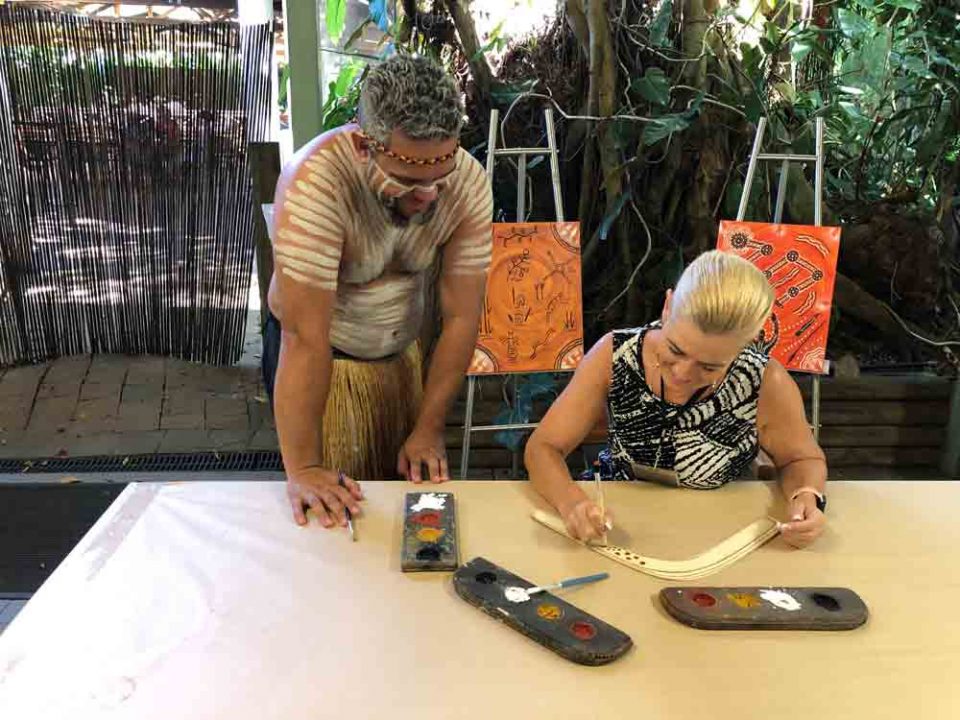Corporate Social Responsibility
Our commitment to corporate social responsibility extends beyond providing exceptional experiences. We actively engage in sustainable practices, prioritizing the preservation of our natural surroundings and supporting the local community. Through initiatives such as wildlife conservation, indigenous cultural awareness programs, and environmentally conscious practices, we aim to make a positive impact. Join us in fostering a responsible and environmentally friendly approach, creating shared value for both your organization and the broader community.
Rainforestation Nature Park

Caring for The Environment
Army Duck Tour & Bush Garden Building
Guests are led to an awaiting Army Duck for an exclusive tour of the rainforest. Learning about the ecological values of the World Heritage protected area, they will be taken to an area cleared for agriculture over 60 years ago that has yet to restore itself to rainforest. Upon arriving at the area guests will disembark the Army Duck and be provided with gloves, water, and suitable instructions will plant saplings into the area before boarding the Army Duck for the return trip.
A commemorative plaque will be placed in the grounds to acknowledge your contribution.
Support the local ecology by planting carefully selected fruiting plants and trees in the Kuranda area. This region serves as a crucial wildlife corridor between larger rainforest tracts to the north and south, making it essential for preserving biodiversity. The chosen plants are all native, fruit-bearing species, fostering a habitat that attracts local wildlife. As the seeds disperse, they contribute to the growth of this vital rainforest area. Beyond ecological benefits, these fruiting plants hold significance in indigenous culture, serving as food and medicinal resources. This initiative aims to preserve indigenous cultural values, providing educational opportunities for years to come.


Commitment to Conservation
Nesting Box Building
Participants will construct a nesting box in teams: constructing, painting and learning about the species that may call the nesting box home and ultimately assist with the conservation of important species to the region.
Scientists have estimated that in nature, a tree hollow takes between 100 to 220 years to form into a usable cavity for animals and birds to utilise as a home. These nest boxes are designed specifically for the tropics and target birds such as Kingfishers, Double Eyed Fig Parrots and mammals such as Sugar Gliders and Striped Possums.
The boxes will be utilised by local volunteer organisations in the protection of endangered and vulnerable species
Natural tree hollows are valuable and essential for many wildlife species. They provide refuge from the weather, predators, and safe sites for roosting and breeding. Wildlife using tree hollows represent 17% birds, 42% mammals and 28% reptiles, including possums, gliders, owls, parrots, antechinus, ducks, bats, snakes and frogs.
Volunteer organisations such as Rainforest Rescue will utilise the nesting boxes in the Wet Tropics and Daintree Rainforests. Rainforest Rescue has two regeneration projects and 39 properties for protection in the Daintree Rainforest where the nesting boxes will be a valued addition for the return of rainforest wildlife to utilise their regenerated areas sooner.


Embracing Reconciliation
Pamagirri Aboriginal Reconciliation & Awareness
PAMAGIRRI CULTURAL PERFORMANCE
Learn about indigenous culture with the interactive Pamagirri Aboriginal Experience. Watch a traditional dance performance in a rainforest Amphitheatre, then join the Dreamtime Walk which includes participational boomerang throwing (weather permitting), demonstrations of spear-throwing and didgeridoo playing to develop a cultural awareness of the importance of our indigenous ancestors.
YARNING CIRCLE
Yarning circles, rooted in the ancient tradition of sharing stories around a fire, provide a non-judgmental space for conversations about Aboriginal culture, history, and adaptation to modern life.
They have existed for thousands of years and focus on storytelling to pass down cultural knowledge. Originally used within Aboriginal communities, yarning circles now serve as inclusive meeting places for both Indigenous and non-Indigenous communities. These circles start with introductions and delve into the history of local tribes, such as the Djabugay and Yindji, and personal stories passed down through generations. While open-ended, suggesting discussion topics to guide the circle with purpose and intention is encouraged


PAMAGIRRI BOOMERANG ART CLASS
Join our creative class, where you’ll explore widely used symbols and painting techniques to unleash your artistic flair. Each participant receives a blank, full-size flight boomerang with a base paint layer, providing a canvas for your imagination. Consider contributing to the community by donating your painted boomerang to local schools through the Pamagirri School programs, fostering a connection with indigenous culture among the youth. The session, lasting approximately 60 minutes, is designed for a minimum of 20 participants and a maximum of 50. Alternatively, delve into our canvas art workshop, offering an 8 x 10 inch canvas per participant or a large group canvas of A2 size (16.5 x 23.4 inches).

